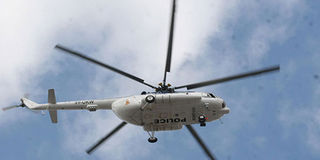Breaking News: At least 10 feared to have drowned in Makueni river
Sh16bn plan for police air wing

Photo/FILE
A police helicopter patrolling Nairobi's central business district.
The fight against crime will take to the air with Sh16 billion being spent to improve the Kenya Police Airwing in the next four years.
The money will help to make the Airwing a rapid deployment anti-crime unit that can be quickly sent in the air to pursue criminals and cattle rustlers.
Internal Security PS Francis Kimemia said the money will be mainly for new aircraft, operations and salaries.
Aircraft operations are estimated to cost Sh2.5 billion while staff costs will be Sh779 million.
Staff will be increased and their pay enhanced to motivate and retain them. Technicians will be increased from 48 to 113.
The current Kenya Police Airwing has 10 helicopter pilots, 13 fixed wing pilots, 18 engineers and technicians, and seven cabin crew.
The Airwing has no deputy commandant after the deputy’s and an MI-17 helicopter pilot’s 2005 contracts ended last month.
The pilots will receive further training as pilots flying the MI-17 aircraft do not meet Civil Aviation Regulations requirements; most commanders don’t have Airline Transport Pilots Licence.
The unit is poorly equipped; out of eight helicopters, five are unserviceable and of the seven Cessna fixed wing aircraft, four are unserviceable.
The fleet, expected to increase to 16 in four years, is expected to do 9,850 flight hours compared to 1,914 flight hours by the Airwing last year.
Sh4.83 billion will be spent in the first year and another Sh3.7 billion in the second year. In the third and fourth financial years, Sh4.1 billion and Sh3.2 billion will be used respectively.
These were part of the recommendations by the 12 member Police Airwing committee of aviation experts appointed on August 24, 2010 as recommended by Justice (Rtd.) Philip Ransely.
The team, led by Col (Rtd) Eutychus K. Waithaka was set up after it came to light that the Airwing’s performance was deteriorating after most aircraft broke down.
There was also a high turnover of experienced pilots and engineers lured by better salaries and benefits elsewhere.
Mr Kimemia said the recommendations would be implemented since the Airwing was instrumental in border patrols, rapid response, anti-terrorism flights, and assistance to ground forces, especially in combating cattle rustling.
The unit has also been used in air transportation of Police and government officials to inaccessible areas and in search and rescue missions.
To ensure a structured employee training for maximum strategic value to the Airwing, Kenya Air Force will help in the selection and training of technicians.
It’s operations rooms will have modern communication, flight and dispatch systems. All Airwing pilots and engineers will be insured for a capital sum of Sh15 million.
The insurance cover for the fleet and crew was discontinued in 2004 and Kenya Civil Aviation Authority granted the Airwing authority to operate without insurance cover.
The commandant will have the authority to make independent financial decisions and hold adequate spares inventory.
It is also recommended that the commandant be upgraded to rank PG13, Senior Deputy Commissioner of Police II.
The former rank was inferior in terms of reporting and consultation due to the big gap. The Airwing is to be rehabilitated in three phases.
Phase I which started in March and ends this month was streamlining procurement, decentralising it and finishing the paper work on the disposal of aircraft beyond economic repair.
In Phase II plans developed in the first year and funded in 2011/2012 Budget will be implemented and the unserviceable aircraft sold.
The final phase will be in the 2012/2013 financial year and will implement all plans funded in that year’s Budget.
However, there are no preventive measures recommended to avert air accidents since the committee failed to obtain accident investigation reports from which lessons would have been learnt.
In 30 years, the Airwing has had nine accidents five of which were fatal. Two were non-fatal but the aircraft were damaged beyond repair while in two other non-fatal accidents, the aircraft were extensively damaged.
The last non-fatal accident was of a fixed wing aircraft 5Y-PAX in May 2009, of a helicopter registration number 5Y-UKW.
The Russian-made helicopter was carrying then Police Commissioner Major General Hussein Ali, Assistant Minister for Internal Security Mr Orwa Ojode, Rift Valley Provincial Commissioner Hassan Noor Hassan and other senior government officials when it developed mechanical problems while taking off from Kipchoge Keino Stadium in Kapsabet. It lost power and plunged on a field in Kapsabet.




